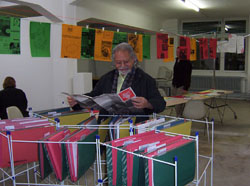Background
Since 2000, B+B have been collecting material on socially engaged, activist and process-based art practices from the UK and internationally. We were motivated to start collecting material in order to map emerging practices and to investigate strategies to re-present process-based projects. 'Collaborative' projects rarely leave behind collective documentation. The leftovers of projects are more often distilled and presented as a singular artwork. Certain documents, stories or objects are prioritised and come to represent the project as a whole. How does this affect the way that projects are remembered and interpreted over time? Can the legacy of a project reflect the chaos of the original experience? What is the best way of collating, tracing and mapping these experiences democratically? What is the potential of the document?
The B+B archive provides a live, ongoing research tool which attempts to question existing cultural paradigms that prioritise, celebrate and critique the singular author. The archive is arranged chronologically rather than being artist-specific. Through events and live-archive projects, we try to gather and chart the experiences of people involved at all levels of the process. This often reveals the hiccups, mistakes, untruths, arguments and disapproval which would otherwise be lost amidst the pressure for 'outcomes' and 'evaluation'.
B+B archive projects
The B+B archive was first presented as a live entity at 'Talk Show', a B+B project in Chicago in June 2002. Project documentation was transported from the UK to an exhibition of activist art practices at the Smart Museum, University of Chicago, to initiate dialogue and investigate legacies of engaged practices in the UK and US. The projects presented were Contact by Amy Plant, Occasional Sights by Anna Best, Cubes by Kathrin Böhm, Andreas Lang and Nicoline van Harskamp and the Penryn Valley Project by Maurice O'Connell. Talk Show used the archive as a starting point for critical discussion and was an experiment in transporting and translating process-based, ongoing projects outside of their original context.
Talk Show
At B+B at Home, nine months after our trans-atlantic archiving process, the B+B archive was brought together and presented as a 'whole' for the first time. With a physical space and lots of stationary to hand, the ACF provided a base from which we could combine the piles of printed matter, start cataloguing and begin to consider ways of opening it up to the public. We worked with interior architects, OFFMO (Samson Adjei and Greg Epps) on new strategies of display for the archive and our workspace. The domestic apparatus used to house and present the material in the archive reflected our roles at B+B at Home as hosts. Sorting, filing, cataloguing, cooking and talking are some the qualities required of a good host. These activities are a visible aspect of our practice and are made evident through the display system created for the archive, for instance the ironing board (which also functioned as a light box) or rotary clothes dryer (which provided a collection point).
B+B at home
The B+B Archive was most recently presented at Soft Logics, an exhibition of archives at the Künstlerhaus in Stuttgart (6 February - April 2004), curated by Elke aus dem Moore and Carmen Mörsch (http://www.kuenslterhaus.de). The B+B Archive at Soft Logics consisted of printed matter on projects that took place in the UK between 1994 and 2004, alongside conference papers, policy documents and articles spanning the same period. Soft Logics provided a chance to meet artists based in Stuttgart. The rotary airer served as a Sammelstelle (collection point) to gather material on current and past projects from Stuttgart.
Soft logics
The B+B Archive as a research tool exists in a variety of arrangements and forms. It also represents a conscious curatorial strategy through which we try to generate 'live-documents'. We have tested this approach through our ongoing research project, B+B on Tour, in which we investigate the turbulent relationship between art and social change by attaching ourselves to specific projects in public space. We aim to place the projects in the wider context of art and politics and create meeting points for critical discussion involving artists, urban planners and key players within the project. The archive becomes a live practice and a critical context for these discussions.
B+B on tour
The B+B archive embodies our ongoing investigation into how to best represent process-based, multi-authored and context-specific projects. During each presentation of the archive we force ourselves to re-plot the stories of the strategies and projects it contains. By animating the material through discussion and collecting material through events, the archive becomes a point of exchange where projects can overlap and new connections can be made. The library, the archive and the website are formats often used to represent collections of experiences and stories because they can be understood as democratic displays of information which capture both transient and fixed moments. The archive collates random moments of productivity. It can become a site to map, network, refer to and rework the projects it hosts as its format is able to retain the multiple experiences of a project. To some extent, archiving even becomes inherent to a process based, collaborative way of working as a parallel activity inseparable from the work itself.

